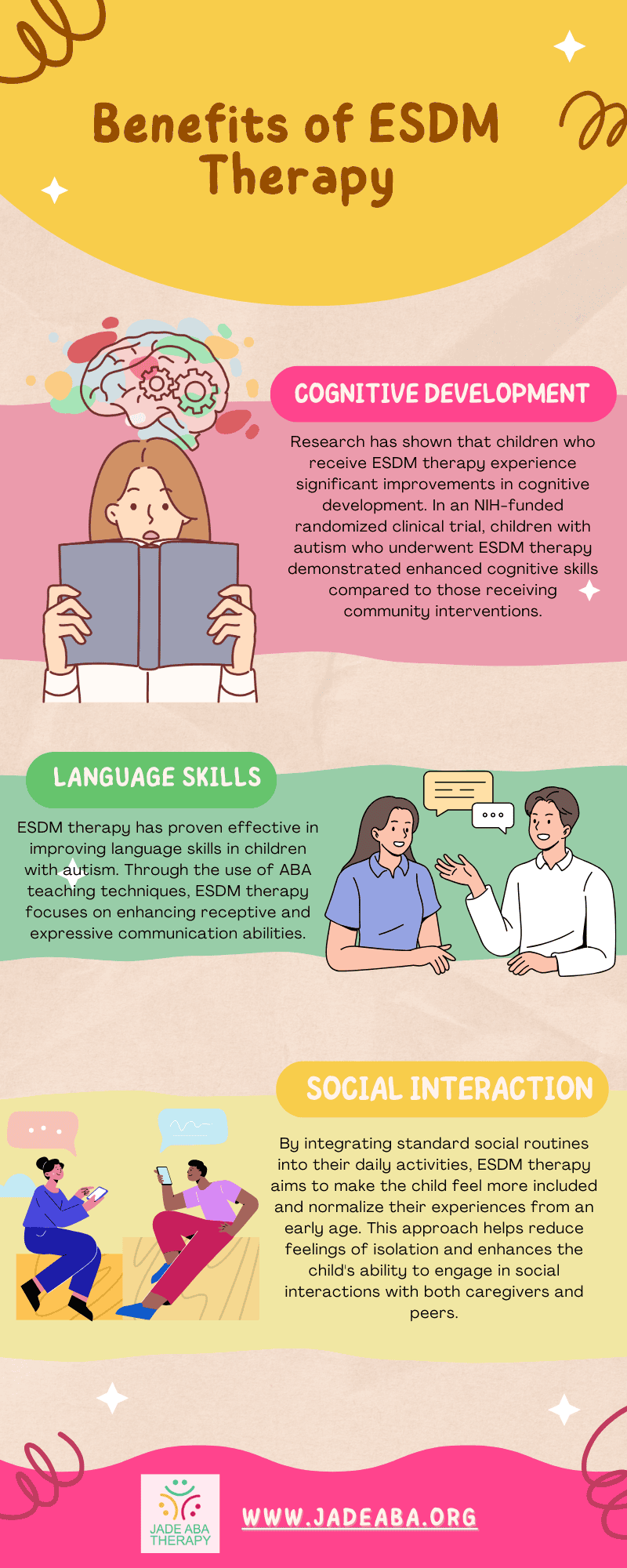The Early Start Denver Model (ESDM) therapy is a comprehensive early intervention approach designed for children between 12 and 48 months, or 1 to 4 years old, who have been diagnosed with or may have autism spectrum disorder (ASD).
It is based on the current understanding of average early childhood development and aims to improve developmental outcomes for autistic children by leveraging this knowledge and understanding of how autism impacts early development.

Play-Based Approach
One of the key features of ESDM therapy is its play-based approach. This therapy utilizes play as a means to engage children with autism in various activities that promote learning and development. Through play, therapists and parents can create a nurturing and enjoyable environment for the child, fostering positive relationships and facilitating learning opportunities.
The play-based approach of ESDM therapy allows children to engage in activities that are developmentally appropriate and tailored to their individual needs. These activities can be incorporated into a child’s regular playtime or daily routines.
ESDM therapy is specifically designed for children between 12 and 48 months of age, a critical period for early intervention. During this time, the brain undergoes rapid development, and interventions that target key developmental areas can have a significant impact on a child’s future outcomes.
By starting therapy at a young age, ESDM aims to capitalize on the brain’s plasticity and the child’s natural ability to learn and adapt. The early intervention provided by ESDM therapy can help address developmental delays and promote positive growth in various domains, such as cognitive, social-emotional, adaptive, and language skills.
It’s important to note that while ESDM therapy has been developed for children within this age range, individualized assessments are essential to determine the suitability of the therapy for each child. The therapy can be adapted to meet the unique needs of older children as well, although it is primarily designed for the target age group.
Benefits of ESDM Therapy
The Early Start Denver Model therapy offers a range of benefits for children with autism spectrum disorder (ASD). This comprehensive early intervention approach focuses on improving developmental outcomes during the crucial early years of a child’s life.
Let’s explore some of its key benefits:

Cognitive Development
Improvements in cognitive development were observed in areas such as problem-solving, attention, memory, and overall intellectual functioning. ESDM therapy equips children with the foundational cognitive skills necessary for their future growth and learning.
Language Skills
Children are encouraged to engage in interactive and meaningful communication during play-based activities. This approach helps children with autism develop their vocabulary, sentence structure, and social communication skills.
By targeting language development early on, ESDM therapy lays the groundwork for improved communication and social interaction.
Social Interaction
One of the core challenges for individuals with autism is social interaction. ESDM therapy addresses this by incorporating one-on-one interactions into a child’s playtime and daily life.
ESDM therapy provides a supportive environment for children with autism to develop essential social skills and build meaningful relationships.
The benefits of ESDM therapy extend beyond cognitive development, language skills, and social interaction. This comprehensive early intervention approach also helps children with autism improve their fine and gross motor skills, play skills, adaptive behavior skills, and relationships with caregivers and peers.
By utilizing ABA teaching techniques and incorporating evidence-based practices, ESDM therapy offers a holistic approach to support the overall development of children with autism spectrum disorder.
Implementation of ESDM

To effectively implement the Early Start Denver Model (ESDM), certain strategies and techniques should be utilized. These include the following:
ABA Teaching Techniques
ESDM incorporates ABA (Applied Behavior Analysis) teaching techniques to improve development in various areas. ABA is a scientifically proven approach that focuses on understanding and changing behavior.
Within ESDM, ABA techniques are used to target specific goals and promote positive behavior changes.
Through the help of ABA principles, ESDM aims to improve receptive and expressive communication, social skills, fine and gross motor skills, cognitive skills, play skills, adaptive behavior skills, and relationships with caregivers and peers. The use of ABA teaching techniques allows for a structured and individualized approach to address the specific needs of each child.
Focus Areas
ESDM therapy focuses on promoting development in several key areas. These areas include cognitive skills, social-emotional skills, adaptive behavior skills, and language skills. The curriculum of ESDM is designed to target these domains and support the overall development of children with ASD.
ESDM aims to accelerate developmental rates and enhance a child’s overall functioning by providing targeted interventions and activities. The focus areas are carefully selected based on the understanding of typical child development and how autism impacts early development.
One-on-One Interactions
One of the distinctive features of ESDM therapy is the emphasis on one-on-one interactions.
This approach aims to incorporate standard socializing routines into the child’s regular playtime and daily life. By doing so, the child is exposed to typical social interactions from an early age, which can help reduce isolation and improve social skills in later life.
During one-on-one interactions, ESDM therapists use naturalistic teaching strategies to engage the child in meaningful activities. These interactions are tailored to the child’s individual needs and interests, creating a supportive and nurturing environment for learning and development.
How Effective is ESDM Therapy?
ESDM therapy has garnered significant attention in the field of autism intervention due to its proven efficacy and positive outcomes. Research findings have shown the impact of ESDM therapy on various aspects of development in children with autism spectrum disorder (ASD).
Let’s explore them in further detail.
Research Findings
Research studies have consistently demonstrated the effectiveness of ESDM therapy in improving outcomes for children with ASD.
A randomized clinical trial funded by the National Institutes of Health (NIH) revealed that children who received ESDM therapy showed significant improvements in cognitive, language, adaptive behavior, and social outcomes compared to those who received community interventions.
This trial also highlighted that children in the ESDM group displayed normalized brain responses to social stimuli.
Furthermore, a two-year follow-up study showed that children who underwent ESDM therapy exhibited an overall improvement of 17.6 points in IQ and maintained their rate of improved adaptive behaviors compared to neurotypical peers. These findings underscore the long-term benefits of ESDM therapy in promoting positive developmental outcomes.
Positive Outcomes
ESDM therapy has been associated with a range of positive outcomes in children with ASD. It has shown significant improvements in cognitive development, including gains in IQ, problem-solving skills, and overall intellectual abilities. Language skills also show improvement through increased vocabulary, better comprehension, and enhanced communication abilities.
In terms of social interaction, ESDM therapy has been effective in fostering social engagement, joint attention, and reciprocal communication. Children who receive ESDM therapy often show progress in developing friendships, engaging in play with peers, and understanding social cues.
Additionally, ESDM therapy has demonstrated advancements in adaptive behaviors, enabling children with ASD to acquire daily living skills, self-help skills, and functional independence, which they’ll need as they transition to adulthood.
This promotes their overall quality of life and prepares them for future success.
Different Delivery Formats

ESDM therapy has been studied and implemented across various delivery formats, all of which have shown positive results. These formats include intensive delivery, parent coaching, and preschool/daycare delivery.
In intensive delivery, children receive ESDM therapy for a significant number of hours each week, typically in a one-on-one setting with a trained therapist. This format allows for focused and individualized intervention.
Parent coaching involves training parents and caregivers to implement ESDM techniques during daily interactions with their children. This empowers parents to support their child’s development and generalize the skills learned in therapy to everyday life.
Preschool/daycare delivery also involves the integration of ESDM strategies within a structured educational setting. This format promotes social interaction, peer learning, and generalization of skills in a group environment.
The research findings and positive outcomes of ESDM therapy validate its efficacy as an early intervention method for children with autism spectrum disorder.
By implementing ESDM therapy through different delivery formats, children with ASD can experience significant improvements in cognitive, language, adaptive behavior, and social skills.